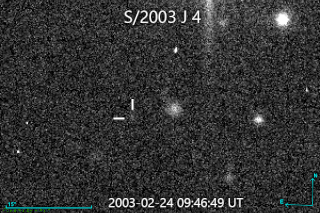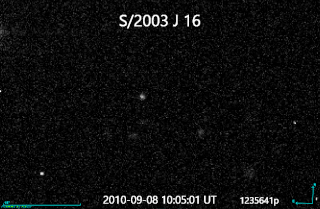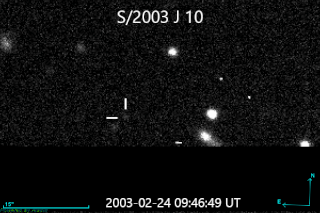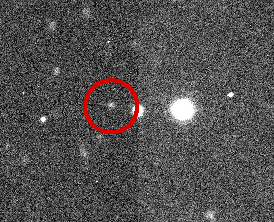Related Research Articles

There are 95 moons of Jupiter with confirmed orbits as of 5 February 2024. This number does not include a number of meter-sized moonlets thought to be shed from the inner moons, nor hundreds of possible kilometer-sized outer irregular moons that were only briefly captured by telescopes. All together, Jupiter's moons form a satellite system called the Jovian system. The most massive of the moons are the four Galilean moons: Io, Europa, Ganymede, and Callisto, which were independently discovered in 1610 by Galileo Galilei and Simon Marius and were the first objects found to orbit a body that was neither Earth nor the Sun. Much more recently, beginning in 1892, dozens of far smaller Jovian moons have been detected and have received the names of lovers or daughters of the Roman god Jupiter or his Greek equivalent Zeus. The Galilean moons are by far the largest and most massive objects to orbit Jupiter, with the remaining 91 known moons and the rings together comprising just 0.003% of the total orbiting mass.

S/2003 J 2 is a retrograde irregular satellite of Jupiter. The moon was discovered on 5 February 2003 by a team of astronomers from the University of Hawaii led by Scott S. Sheppard and David C. Jewitt, and was later announced on 4 March 2003. It was initially thought to be Jupiter's outermost known moon until recovery observations disproved this in 2020.

Eupheme, also Jupiter LX, originally known as S/2003 J 3, is an outer natural satellite of Jupiter, 2 km in diameter.

S/2003 J 4 is a natural satellite of Jupiter. It was discovered by a team of astronomers from the University of Hawaii led by Scott S. Sheppard in 2003.
Eirene, also Jupiter LVII and originally known as S/2003 J 5, is a retrograde irregular satellite of Jupiter. It was discovered by a team of astronomers from the University of Hawaii led by Scott S. Sheppard in 2003 but was then lost. It was recovered in 2017 and given its permanent designation that year.

S/2003 J 16 is a natural satellite of Jupiter. It was discovered by a team of astronomers led by Brett J. Gladman in 2003.

S/2003 J 10 is a retrograde irregular satellite of Jupiter. It was discovered by a team of astronomers from the University of Hawaii led by Scott S. Sheppard et al. in 2003.

S/2003 J 12 is a natural satellite of Jupiter, and is one of the smallest known natural satellites in the Solar System. It was discovered by a team of astronomers from the University of Hawaii led by Scott S. Sheppard in 2003.
Philophrosyne, also Jupiter LVIII and provisionally known as S/2003 J 15, is a natural satellite of Jupiter. It was discovered by a team of astronomers from the University of Hawaii led by Scott S. Sheppard, et al. in 2003, but then lost. It was recovered in 2017 and given its permanent designation that year.

S/2003 J 16 is a natural satellite of Jupiter. It was discovered by a team of astronomers led by Brett J. Gladman in 2003.

Jupiter LV, provisionally known as S/2003 J 18, is a natural satellite of Jupiter. It was discovered by a team of astronomers led by Brett J. Gladman in 2003.
Jupiter LXI, provisionally known as S/2003 J 19, is a natural satellite of Jupiter. It was discovered by a team of astronomers led by Brett J. Gladman, et al. in 2003.

S/2003 J 23 is a natural satellite of Jupiter. It was discovered by a team of astronomers from the University of Hawaii led by Scott S. Sheppard et al. in 2004 from pictures taken in 2003.
S/2004 S 12 is a natural satellite of Saturn. Its discovery was announced by Scott S. Sheppard, David C. Jewitt, Jan Kleyna, and Brian G. Marsden on 4 May 2005 from observations taken between 12 December 2004 and 9 March 2005.
S/2004 S 17 is a natural satellite of Saturn. Its discovery was announced by Scott S. Sheppard, David C. Jewitt, Jan Kleyna, and Brian G. Marsden on 4 May 2005 from observations taken between 13 December 2004 and 5 March 2005.
S/2004 S 13 is a natural satellite of Saturn. Its discovery was announced by Scott S. Sheppard, David C. Jewitt, Jan Kleyna, and Brian G. Marsden on 4 May 2005 from observations taken between 12 December 2004 and 9 March 2005.
S/2006 S 1 is a natural satellite of Saturn. Its discovery was announced by Scott S. Sheppard, David C. Jewitt, Jan Kleyna, and Brian G. Marsden on June 26, 2006 from observations taken between January 4 and April 30, 2006. S/2006 S 1 is about 6 kilometres in diameter, and orbits Saturn at an average distance of 18.65 Gm in 951.1 days, at an inclination of 154.6° to the ecliptic, in a retrograde direction and with an eccentricity of 0.0814.
S/2006 S 3 is a natural satellite of Saturn. Its discovery was announced by Scott S. Sheppard, David C. Jewitt, Jan Kleyna, and Brian G. Marsden on June 26, 2006 from observations taken between January and April 2006.
S/2007 S 2 is a natural satellite of Saturn. Its discovery was announced by Scott S. Sheppard, David C. Jewitt, Jan Kleyna, and Brian G. Marsden on May 1, 2007, from observations taken between January 18 and April 19, 2007. S/2007 S 2 is about 5 kilometres in diameter, and orbits Saturn at an average distance of 16,054,500 kilometres in 759.2 days, at an inclination of 176.65° to the ecliptic, in a retrograde direction and with an eccentricity of 0.237. According to Denk et al. (2018), it is presumably at high risk of colliding with Phoebe in the future.
Jupiter LXXII, originally known as S/2011 J 1, is a natural satellite of Jupiter. It was discovered by Scott Sheppard in 2011. It belongs to the Carme group.
References
- ↑ S.S. Sheppard (2019), Moons of Jupiter, Carnegie Science, on line
- ↑ MPEC 2012-B97 : S/2011 J 1 AND S/2011 J 2 2012 Jan. 29 (discovery)
- ↑ Jupiter's Known Satellites
- ↑ "Two New Moons Found Orbiting Jupiter". news.nationalgeographic.com. 2012-02-03. Archived from the original on February 4, 2012. Retrieved 2016-04-28.
- ↑ Beatty, Kelly (4 April 2012). "Outer-Planet Moons Found — and Lost". www.skyandtelescope.com. Sky & Telescope. Retrieved 27 June 2017.
- ↑ Brozović, Marina; Jacobson, Robert A. (9 March 2017). "The Orbits of Jupiter's Irregular Satellites". The Astronomical Journal. 153 (4): 147. Bibcode:2017AJ....153..147B. doi: 10.3847/1538-3881/aa5e4d .
- ↑ Jacobson, B.; Brozović, M.; Gladman, B.; Alexandersen, M.; Nicholson, P. D.; Veillet, C. (28 September 2012). "Irregular Satellites of the Outer Planets: Orbital Uncertainties and Astrometric Recoveries in 2009–2011". The Astronomical Journal. 144 (5): 132. Bibcode:2012AJ....144..132J. doi: 10.1088/0004-6256/144/5/132 . S2CID 123117568.
- ↑ Sheppard, Scott S. (2017). "New Moons of Jupiter Announced in 2017". home.dtm.ciw.edu. Retrieved 27 June 2017.
We likely have all of the lost moons in our new observations from 2017, but to link them back to the remaining lost 2003 objects requires more observations a year later to confirm the linkages, which will not happen until early 2018. ... There are likely a few more new moons as well in our 2017 observations, but we need to reobserve them in 2018 to determine which of the discoveries are new and which are lost 2003 moons.
- ↑ Sheppard, Scott S. (2017). "Jupiter's Known Satellites". home.dtm.ciw.edu. Archived from the original on 20 July 2017. Retrieved 10 August 2017.